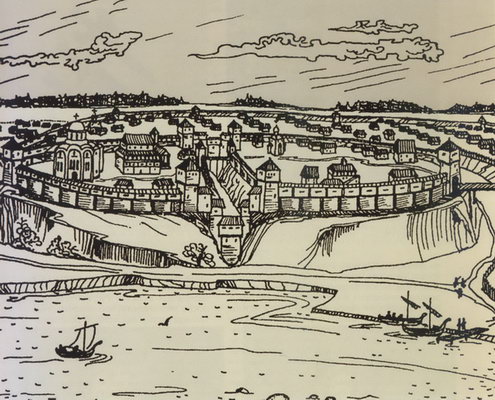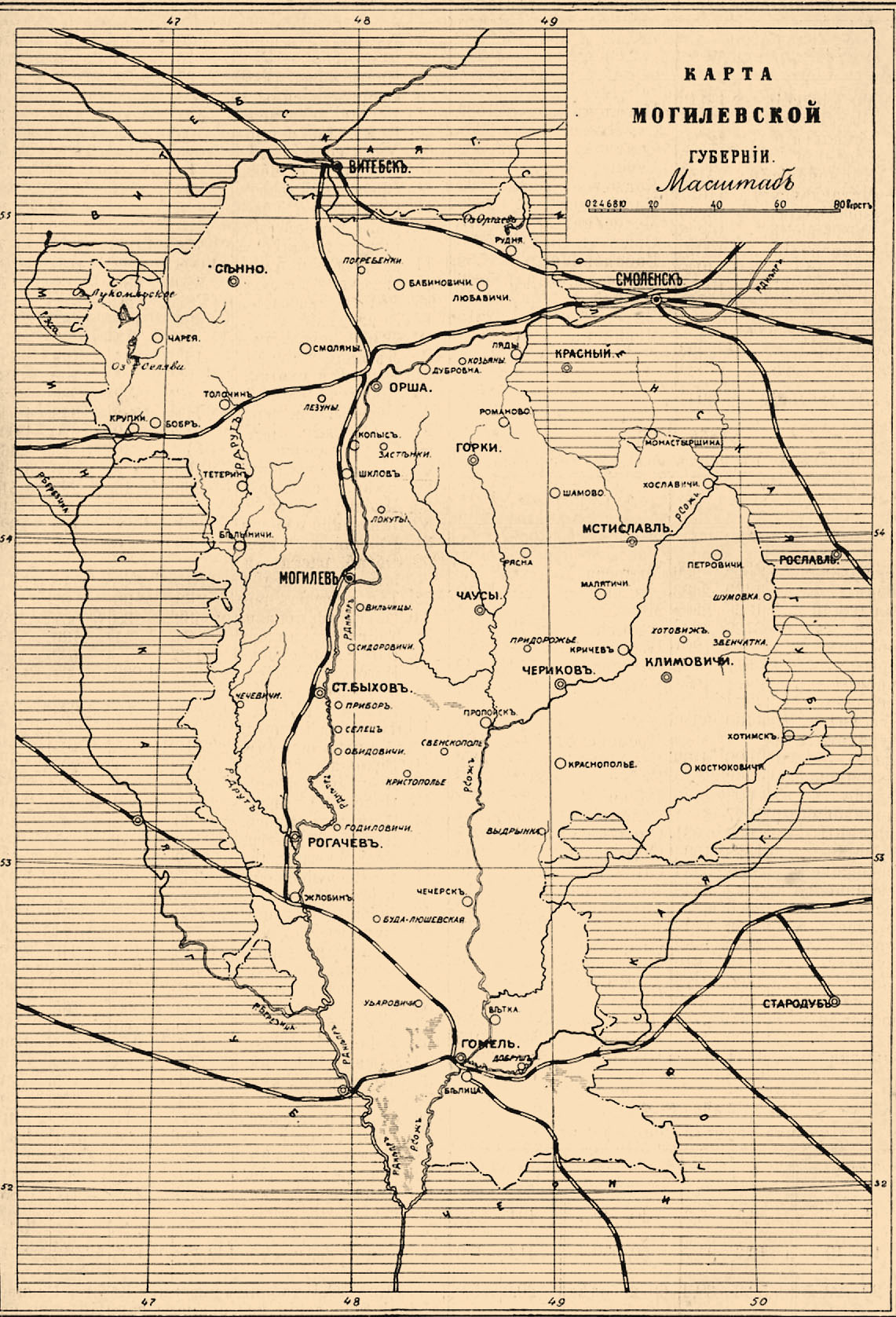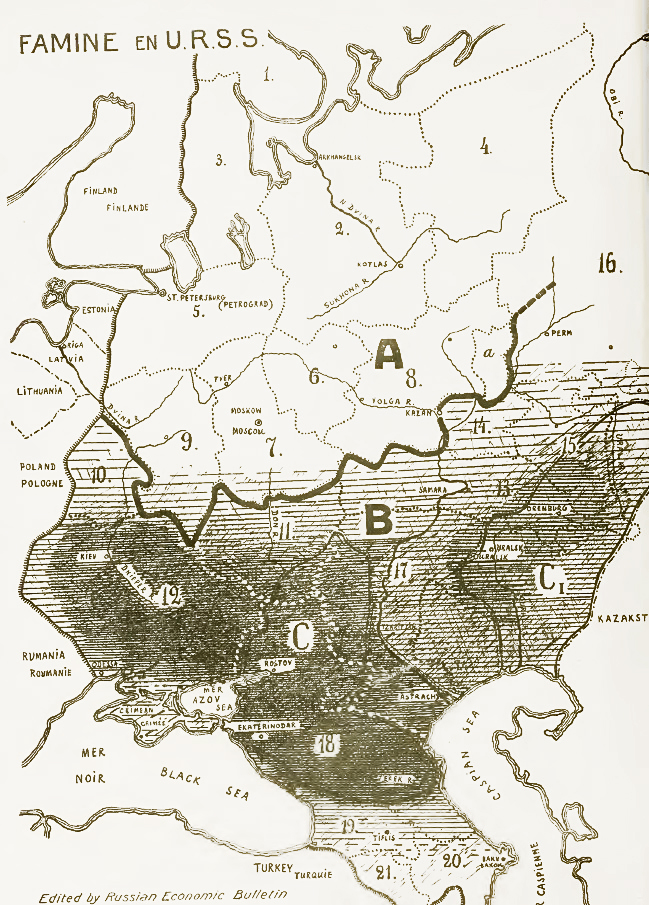|
Dovsk
Dovsk or Dowsk (; russian: Довск) is an Agrotown (Belarus), agrotown in Rahachow District, Gomel Region, Belarus. It serves as the administrative center of Dovsk selsoviet. Clay deposits are located near town, and it is bordered by forest from east and west. History Before 1900 Burial mounds (27) discovered by archaeologists, on the southwestern outskirts date to the ancient times. After the First Partition of Poland (1772) it became part of the Russian Empire. In 1850, the Saint Petersburg, St. Petersburg - Kyiv, Kiev highway passed through the village. According to the revision of 1858, it was the property of D.P. Turcheninov. In 1860, the post office was moved to Dovsk from Yamnoye, at the crossroads of trade routes. In 1864, in the heart of the village at the old church site known since 1836, the brick Holy Intercession Church, Dovsk Holy Intercession Church was built. The center of spiritual life moved there from Malashkovichi village. An ongoing sugar production ... [...More Info...] [...Related Items...] OR: [Wikipedia] [Google] [Baidu] |
Holy Intercession Church
Dovsk Church of the Intercession of the Most Holy Theotokos was built in 1864. Prior to this, the nearest church was located in the village of Malashkovichi. In 1860 clergyman Anthony Yurkevich served here. In 1860 the postal station was transferred from the village of Yamnoye to the village of Dovsk, and in the same year a church burned down in the village of Malashkovichi. After the uprising of 1863–1864, the federal government financed the construction of Orthodox churches throughout Belarus. As part of this program, funds were allocated for the construction of a new temple in Malashkovichi, but natural forces decided to build it in Dovsk. In 1935, the church was closed and used for economic purposes. Within the walls of the building there was a warehouse, a shop, a restaurant. In July 1990, it was transferred by the district executive committee to the Orthodox community. Now the church has a Sunday school and a library. This temple is a monument of pseudo-classical ar ... [...More Info...] [...Related Items...] OR: [Wikipedia] [Google] [Baidu] |
Agrotown (Belarus)
An agrotown ( be, аграгарадок, ahraharadok; russian: агрогородок, agrogorodok) is an official type of rural settlement in Belarus introduced by a law passed in 1998. The law defines agrotowns as well-developed rural settlements with industrial and social infrastructure to ensure social standards for population living there and in the surrounding areas. The law further says that if a ''selsoviet'' (rural district) has agrotowns, its administrative center must be in an agrotown. If there is more than one agrotown, the selsoviet center is assigned by the Districts of Belarus, District Council of Deputies. References Types of populated places Agrotowns in Belarus, Rural geography {{belarus-geo-stub ... [...More Info...] [...Related Items...] OR: [Wikipedia] [Google] [Baidu] |
Khutor
A khutor ( rus, хутор, p=ˈxutər) or khutir ( uk, хутiр, pl. , ''khutory'') is a type of rural locality in some countries of Eastern Europe; in the past the term mostly referred to a single-homestead settlement.Khutor from the Khutor from the Brockhaus and Efron Encyclope ...
[...More Info...] [...Related Items...] OR: [Wikipedia] [Google] [Baidu] |
Populated Places In Gomel Region
Population typically refers to the number of people in a single area, whether it be a city or town, region, country, continent, or the world. Governments typically quantify the size of the resident population within their jurisdiction using a census, a process of collecting, analysing, compiling, and publishing data regarding a population. Perspectives of various disciplines Social sciences In sociology and population geography, population refers to a group of human beings with some predefined criterion in common, such as location, race, ethnicity, nationality, or religion. Demography is a social science which entails the statistical study of populations. Ecology In ecology, a population is a group of organisms of the same species who inhabit the same particular geographical area and are capable of interbreeding. The area of a sexual population is the area where inter-breeding is possible between any pair within the area and more probable than cross-breeding with ind ... [...More Info...] [...Related Items...] OR: [Wikipedia] [Google] [Baidu] |
Babruysk
Babruysk, Babrujsk or Bobruisk ( be, Бабруйск , Łacinka: , rus, Бобруйск, Bobrujsk, bɐˈbruɪ̯s̪k, yi, באָברויסק ) is a city in the Mogilev Region of eastern Belarus on the Berezina River. , its population was 209,675. The name Babrujsk (as well as that of the Babruyka River) probably originates from the Belarusian word (; 'beaver'), many of which used to inhabit the Berezina. However, beavers in the area had been almost eliminated by the end of the 19th century due to hunting and pollution. Babrujsk occupies an area of , and comprises over 450 streets whose combined length stretches for over . Babrujsk is located at the intersection of railroads to Asipovichy, Zhlobin, Aktsyabrski and roads to Minsk, Homyel, Mahilyow, Kalinkavichy, Slutsk, and Rahachow. It has the biggest timber mill in Belarus, and is also known for its chemical, machine building and metal-working industries. In 2021, there were 38 public schools in Babrujsk, with over 2 ... [...More Info...] [...Related Items...] OR: [Wikipedia] [Google] [Baidu] |
Gomel
Gomel (russian: Гомель, ) or Homiel ( be, Гомель, ) is the administrative centre of Gomel Region and the second-largest city in Belarus with 526,872 inhabitants (2015 census). Etymology There are at least six narratives of the origin of the city's name. The most plausible is that the name is derived from the name of the stream Homeyuk, which flowed into the river Sozh near the foot of the hill where the first settlement was founded. Names of other Belarusian cities are formed along these lines: for example, the name Minsk is derived from the river Menka, Polatsk from the river Palata, and Vitsebsk from the river Vitsba. The first appearance of the name, as "Gomy", dates from 1142. Up to the 16th century, the city was mentioned as Hom', Homye, Homiy, Homey, or Homyi. These forms are tentatively explained as derivatives of an unattested ''*gomŭ'' of uncertain meaning. The modern name for the city has been in use only since the 16th or 17th centuries. History Unde ... [...More Info...] [...Related Items...] OR: [Wikipedia] [Google] [Baidu] |
Zhlobin
Zhlobin ( be, Жло́бін; russian: Жло́бин, pl, Żłobin, lt, Žlobinas) is a city in the Zhlobin District of Gomel Region, Belarus, located on the Dnieper river. As of 2017, the population was 76,078. The city is notable for being the location where steelmaker BMZ was established. BMZ is one of the largest companies in Belarus, and an important producer in the worldwide markets of steel wires and cords. The company is the main sustainer of the town's economy. History In 1939, 19% of the town's population was Jewish. During World War II, Zhlobin was occupied by the German Army from 3 July 1941 until 13 July 1944. The Nazis captured the Jews and imprisoned them in 2 different ghettos, where they suffered from starvation, disease and abuse. On April 12, 1942, 1,200 Jews were murdered in the ghettos. Sport Metallurg Zhlobin of the Belarusian Extraleague is the local pro hockey team. Industrial enterprises of Zhlobin * OJSC "BMZ - managing company of the holdin ... [...More Info...] [...Related Items...] OR: [Wikipedia] [Google] [Baidu] |
Mogilev
Mogilev (russian: Могилёв, Mogilyov, ; yi, מאָלעוו, Molev, ) or Mahilyow ( be, Магілёў, Mahilioŭ, ) is a city in eastern Belarus, on the Dnieper River, about from the border with Russia's Smolensk Oblast and from the border with Russia's Bryansk Oblast. , its population was 360,918, up from an estimated 106,000 in 1956. It is the administrative centre of Mogilev Region and the third-largest city in Belarus. History The city was first mentioned in historical records in 1267. From the 14th century, it was part of the Grand Duchy of Lithuania, and since the Union of Lublin (1569), part of the Polish–Lithuanian Commonwealth, where it became known as ''Mohylew''. In the 16th-17th centuries, the city flourished as one of the main nodes of the east–west and north–south trading routes. In 1577, Polish King Stefan Batory granted it city rights under Magdeburg law. In 1654, the townsmen negotiated a treaty of surrender to the Russians peacefully, if ... [...More Info...] [...Related Items...] OR: [Wikipedia] [Google] [Baidu] |
Holodomor
The Holodomor ( uk, Голодомо́р, Holodomor, ; derived from uk, морити голодом, lit=to kill by starvation, translit=moryty holodom, label=none), also known as the Terror-Famine or the Great Famine, was a man-made famine in Soviet Ukraine from 1932 to 1933 that killed millions of Ukrainians. The Holodomor was part of the wider Soviet famine of 1932–1933 which affected the major grain-producing areas of the Soviet Union. While scholars universally agree that the cause of the famine was man-made, whether the Holodomor constitutes a genocide remains in dispute. Some historians conclude that the famine was planned and exacerbated by Joseph Stalin in order to eliminate a Ukrainian independence movement. This conclusion is supported by Raphael Lemkin. Others suggest that the famine arose because of rapid Soviet industrialisation and collectivization of agriculture. Ukraine was one of the largest grain-producing states in the USSR and was subject to unre ... [...More Info...] [...Related Items...] OR: [Wikipedia] [Google] [Baidu] |
Soviet Famine Of 1932–1933
The Soviet Union,. officially the Union of Soviet Socialist Republics. (USSR),. was a transcontinental country that spanned much of Eurasia from 1922 to 1991. A flagship communist state, it was nominally a federal union of fifteen national republics; in practice, both its government and its economy were highly centralized until its final years. It was a one-party state governed by the Communist Party of the Soviet Union, with the city of Moscow serving as its capital as well as that of its largest and most populous republic: the Russian SFSR. Other major cities included Leningrad (Russian SFSR), Kiev (Ukrainian Soviet Socialist Republic, Ukrainian SSR), Minsk (Byelorussian Soviet Socialist Republic, Byelorussian SSR), Tashkent (Uzbek Soviet Socialist Republic, Uzbek SSR), Almaty, Alma-Ata (Kazakh Soviet Socialist Republic, Kazakh SSR), and Novosibirsk (Russian SFSR). It was the largest country in the world, covering over and spanning Time in Russia, eleven time zones. T ... [...More Info...] [...Related Items...] OR: [Wikipedia] [Google] [Baidu] |
Ukraine
Ukraine ( uk, Україна, Ukraïna, ) is a country in Eastern Europe. It is the second-largest European country after Russia, which it borders to the east and northeast. Ukraine covers approximately . Prior to the ongoing Russian invasion, it was the eighth-most populous country in Europe, with a population of around 41 million people. It is also bordered by Belarus to the north; by Poland, Slovakia, and Hungary to the west; and by Romania and Moldova to the southwest; with a coastline along the Black Sea and the Sea of Azov to the south and southeast. Kyiv is the nation's capital and largest city. Ukraine's state language is Ukrainian; Russian is also widely spoken, especially in the east and south. During the Middle Ages, Ukraine was the site of early Slavic expansion and the area later became a key centre of East Slavic culture under the state of Kievan Rus', which emerged in the 9th century. The state eventually disintegrated into rival regional po ... [...More Info...] [...Related Items...] OR: [Wikipedia] [Google] [Baidu] |
German Occupation Of Byelorussia During World War II
German invasion of the Soviet Union on 22 June 1941 led to the military occupation of Byelorussia until August 1944 with the Soviet Operation Bagration. The western parts of Byelorussia became part of the Reichskommissariat Ostland in 1941, and in 1943 the German authorities allowed local collaborators to set up a regional government, the Belarusian Central Rada, that lasted until the Soviets reestablished control over the region. During the occupation, German actions led to about 1.6 million civilian deaths including 500,000 to 550,000 Jews in the Holocaust in Belarus. Background The Soviet and Belarusian historiographies study the subject of German occupation in the context of contemporary Belarus, regarded as the Byelorussian Soviet Socialist Republic (BSSR), a constituent republic of the Soviet Union in the 1941 borders as a whole. Polish historiography insists on special, even separate treatment for the East Lands of the Poland in the 1921 borders (alias "''Kresy Wschod ... [...More Info...] [...Related Items...] OR: [Wikipedia] [Google] [Baidu] |






